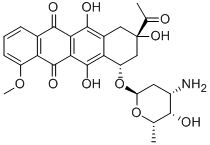| Daunorubicin |
|
| (CAS 20830-81-3) |
 |
| Description: |
Daunorubicin(RP13057) inhibits both DNA and RNA synthesis and inhibits DNA synthesis with Ki of 0.02 μM.
IC50 value: 0.02 uM (Ki for inhibition of DNA synthesis)
Target: ADCs cytotoxin; anticancer
in vitro: Daunorubicin inhibits both DNA and RNA syntheses in HeLa cells over a concentration range of 0.2 through 2 μM. Daunorubicin inhibits both DNA syntheses in Ehrlich ascites tumor cells over a concentration range of 4 μM. Daunorubic triggers apoptosis at concentrations of 0.5 and 1 μM in either HL-60 or U-937 human leukemic cells [1]. Daunorubicin stimulates ceramide elevation and apoptosis in P388 and U937 cells through de novo synthesis via activation of the enzyme ceramide synthase[2]. Daunorubicin dose-dependently increases the phosphatidylserine exposure and consequent procoagulant activity of human umbilical vein endothelial cells. Daunorubicin (0.2 mM) significantly enhances the release of endothelial microparticles which are highly procoagulant in human umbilical vein endothelial cells[3].
in vivo: daunorubicin inhibited the proliferation of KG1a cells in a dose and time dependent manner (r = 0.983, P < 0.01).Daunorubicin could reduce the mRNA and protein levels of Eps8 expression in dose and time dependent manners in KG1a cells (r = 0.979, P < 0.05) [4].
|
| Product No. |
KT20887 |
| Product Name |
Daunorubicin |
| Synonyms |
|
| Formal Name |
|
| CAS Number |
20830-81-3 |
| Molecular Formula |
C27H29NO10 |
| Formula Weight |
527.52 |
| Formulation |
A crystalline solid |
| Purity |
98%min |
| Stability |
2 years |
| Storage |
-20°C |
| Shipping |
USD45 for Europe and USA. No shipping charge once amount reach USD500 |
| Quality Control |
HNMR,CNMR,LCMS,HPLC,IR,etc. |
| Price & Availability |
In Stock. Price Negotiated. |
|
| Related Products: |
10-Deacetyl-7-xylosyl paclitaxel
10-Deacetyl-7-xylosyl paclitaxel is a Paclitaxel derivative with improved pharmacological features and higher water solubility.
IC50 value:
Target: Microtubule inhibitor
10-Deacetyl-7-xylosyl paclitaxel induced mitotic cell cycle arrest and apoptosis as measured by flow cytometry, DNA laddering, and transmission electron microscopy. Pro-apoptotic Bax and Bad protein expression was up-regulated and anti-apoptotic Bcl-2 and Bcl-XL expression down-regulated, which lead to a disturbance of the mitochondrial membrane permeability and to the activation of caspase-9. In turn, caspase-9 activated downstream caspases-3 and -6, but not caspase-8. Bid was also activated by caspase-3. Reversely, treatment with a caspase-10-specific inhibitor could not protect PC-3 cells from 7-xylosyl-10-deacetyl-paclitaxel-triggered apoptosis. Moreover, 7-xylosyl-10-deacetylpaclitaxel had no effect on the expression of CD95 and NF-kappaB proteins, indicating that apoptosis was induced through the mitochondrial-dependent pathway in PC-3 cells.
|
|


